|
A Broadcast Engineer in Korea
What it was like, bouncing around the
Korean Hills
with the Armed Forces Radio Service
by JOHN D. HARMER
Transmitter Engineer
WCOL, Columbus, Ohio
©Radio. TV and Recording "Technician - Engineer" : June
1957
(Thanks to Al Quaglieri for cleaning up the images )
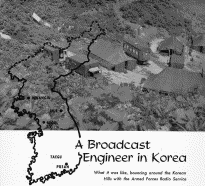
Click for larger image 2 meg file
UPON my arrival in Korea early in 1952 as an enlisted man in the U. S.
Army, I was processed and forwarded to the 25th Infantry Division, which
was at that time assigned to combat duty on the line.
I served with the infantry for about one year before I was transferred
to the Armed Forces Radio Service.
Radio broadcast engineering was my business before I was sent to Korea,
and I was anxious to get back into it, and AFRS as
it turned out, was that possibility.
The headquarters of the then Far East Network in Korea was in Taegu,
South Korea, where EUSAK (The Eighth Army Headquarters) was located, and
consisted of five stations. Later, the network was renamed the American
Forces Korea Network and was increased from five to nine stations.
Of the original five, one was in Pusan, on the Southern most point of
the peninsula, the headquarters station in Taegu, a station in Seoul, the
country's capital, and two in North Korea at Kumwha and Inje.
|
|
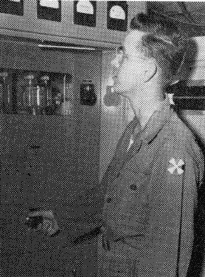 |
The author tuning a Gates BC-IF
transmitter at "Homesteader," Pusan.
Click for larger image |
| |
|
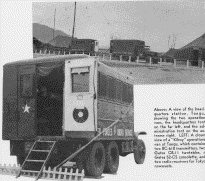
Click for larger image
|
Above: A view of the headquarters station,
Taegu, showing the two operation vans, the headquarters tent on the far
left, and the administration tent on the extreme right. LEFT: A closer
view of a "Kilroy" operations van at Taegu, which contains two
BC-610 transmitters, two Gates CB-11 turntables, a Gates 52-CS consolette,
and two radio receivers for Tokyo newscasts. |
| The stations were not identified
by call signs as we know them, but rather were assigned proper names, such
as : VAGABOND, GYPSY, TROUBADOR, HOMESTEADER, etc. The Far East Command (FEC),
in addition to calls, also assigned the operating power and frequencies
for the different stations in the standard broadcast band, however, all
were above 1 megacycle per second.
This was done, primarily, with the fact in mind that many of the
stations would have to operate the BC-610 communications transmitter as a
broadcast rig, even though each AFRS radio station was authorized a
broadcast type transmitter, many times supply channels were overloaded to
the point, particularly in a combat zone, where acquisition of a broadcast
transmitter was not consummated for some time.
The middle of 1952 saw the war going much better our way, and the
establishment of four more radio stations, these
last four with an operating power of 1 kilowatt each. The principal one
was at Chunchon, North Korea, installed with the Gates BC-IF broadcast
transmitter.
Of the nine stations in the AFKN, six were equipped with the Gates 1
kilowatt broadcast transmitter, and the remaining three used the BC-610 in
a static situation until 1953, when I was relieved of duty and shipped
back home.
The majority of our personnel came to us through their own request for
transfer, hence they usually had previous experience in the broadcasting
industry, as announcers, engineers, administrators, etc.
Turnover was somewhat of a problem inasmuch as some of the men had seen
combat duty before coming to us, and there were times when we were extremely
short of experienced personnel, particularly in view of the fact that we
operated all stations in the net on a 24-hour-a-day basis. |
|

Click for larger image
ABOVE LEFT: Inside a van at "Troubador," located at Inie,
North Korea. At left is a Gates CB-11 turntable; at
right, a Gates 52 CS consolette. An RCA 88A mike was used; time was
synchronized with FEN and WWVH, Hawaii, on message center clock. Another
turntable and two receivers are above the console on shelf with a cueing
amplifier.
ABOVE RIGHT: The control room van at "Vagabond" in Seoul.
Installed here were two Presto 64A turntables, a WE 23C console, a
Magnecord PT6-P tape recorder, two radio receivers-a BC-1004 (Hammarlund
Super Pro with BC band) and an RCA 91 A-plus the station's record library.
|
| Our news broadcasts came to us
through the shortwave transmitters of the Far East Network (FEN)-JKI, and
JKL, operating in the 19 and 25 meter bands out of Tokyo. All news
releases had to go first to the Far East Command in Tokyo for clearance
and release to us, via SW, and the three major American News Services of
the AP, UP, and the INS.
Our 2400-hour operation was in line with the fact that our entire
sphere of operations took place within a combat zone, with AFRS electrical
transcription programming constituting approximately 12 hours of the
broadcast day.
The Armed Forces Radio Service has been a valuable service in the
conduct of war, not only as the immediate voice of the area commander to
which it is assigned, but as the bridge between the lonely GI in a strange
faraway land and his home in the States.
EDITOR'S NOTE: John D. Harmer, author of this article, was first
associated with the Armed Forces Radio Service as a staff engineer. Later
he became chief engineer of the American Forces Korean Network. As a
transmitter engineer at WCOL, Columbus, Ohio, Harmer is now a member of
Local 1300, International Brotherhood of Electrical Workers.
The story of his experience in Korea came to us in a letter with the
pictures on this and the accompanying pages. If you have had a
broadcasting or recording experience to pass on to our readers, send a
letter and pictures to Albert O. Hardy, Editor, TECHNICIAN-ENGINEER, IBEW,
1200 Fifteenth Street, N. W., Washington, D. C.
|
|

Click for larger image
|
|
This was one of the later arrangements at "Kilroy," after
moving from the temporary vans to quonset buildings. Here are two RCA 700
turntables, and RCA 91 A radio, Gates 52 CS consolette, Hammarlund SP 600
radio, and a Magnecord PT6-P tape recorder.
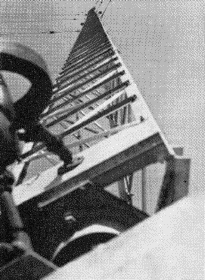
Click for larger image
ABOVE: Looking up the 18S-foot radiator installed at
"Vagabond" in Seoul, across the base insulator and the Austin
tower lighting transformer.
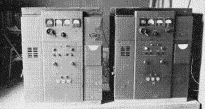
Click for larger image
LEFT: After moving to permanent buildings the GI broadcasters installed
these two BC-610 E transmitters, modified slightly for continuous service
broadcasting.
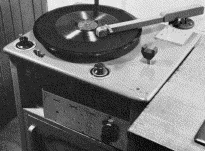
Click for larger image
LEFT: An example of the ingenuity of the engineering department of the
AFKN where some of the newer stations that were established didn't even
have the basic requirements of transcription turntables.
This turntable and others like it were designed and constructed under
Harmer's direction using little GI 10" turntables and adapting them
with a 16" table platter, installing them in cabinets constructed
with the RCA MI-4875G pickup kit, with a two-speed shift and handle
mechanism designed by Harmer. The panel, key switch and attenuator were
part of a testing circuit.
Even though not broadcast quality to the standards of the industry,
these were entirely adequate for our purposes and with a little care were
satisfactory. Adequate or not, they had to be used.
Technician-Engineer |
| |
| |
| |
|